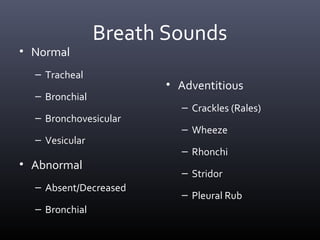List and Describe 3 Types of Normal Breath Sounds
Learn lung auscultation points and normal breath sounds vs abnormal breath sounds. Normal Loc - Trachea and Larynx Bronchovesicular Moderate pitch.

Normal Breath Sounds Download Table
Tubular cavernous and amphoric.

. Quality - mixed. These may be easily audible or identified through auscultation of the respiratory system through the lung fields with a stethoscope as well as from the spectral characteristics of lung sounds. Normal Vesicular Adventitious Abnormal breath sounds Normal Vesicular It occurs when vocal cords vibrate during inhalation and exhalation.
Vesicular breath sounds and bronchial breath sounds are two types of normal breath sounds. In addition you will be able to identify the location of these breath sounds within the respiratory system. This article will highlight everything you need to know about assessing a patients lung sounds.
Decreased absent and adventitious lung sounds eg. Sounds heard during auscultation of the chest of a healthy person. Normal Loc - Trachea and Larynx Bronchovesicular Moderate pitch.
High pitch loud inspiration Bronchovesicuclar. Anterior upper sternum in 1st and 2nd. Bronchial bronchovesicular and vesicular.
Quality - harsh hollow tubular. Respiratory sounds also known as lung sounds or breath sounds refer to the specific sounds generated by the movement of air through the respiratory system. List and describe 3 types of normal breath sounds.
Quality - harsh hollow tubular. Listening to lung sounds are a vital part of this assessment. How pitch soft inspiration.
Tracheal Breath Sounds Tracheal breath sounds are loud and high-pitched and are heard primarily over. Normal Loc - over major bronchi where fewer alveoli are located Vesicular Low pitch. 10 rows the breath sound during a complete inspiration and expiration Compare findings at each point.
Duration - inspiration expiration. They are harsh and loud. List and describe abnormal eg.
Duration- inspiration expiration. There are two types normal and abnormal adventitious breath sounds. Mainly lung sounds divided into 2 types.
List and describe 3 types of normal breath sounds. Duration - inspiration expiration. Bronchial Tracheal High pitch.
They can be heard all over the chest and the back. -Bronchial - high pitch loud inspiration. Describe the three types of normal breath sounds.
List and describe 3 types of normal breath sounds. Rales can be further described as moist dry fine or coarse. Duration - inspiration expiration.
Small clicking bubbling or rattling sounds in the lungs. Normal breath sounds are divided into two subcategories. Rhonchi a low-pitched breath sound crackles a high-pitched breath sound wheezing a high-pitched whistling sound caused by narrowing of the bronchial tubes stridor a harsh vibratory sound.
These sounds are high-pitched and hollow-sounding. Normal Loc - over major bronchi where fewer alveoli are located. Normal Loc - Trachea and Larynx.
As a nursing student or nurse it is important you know how to correctly assess a patient during a head-to-toe assessment. Bronchial Tracheal High pitch. In the previous reviews I discussed abnormal breath sounds and how to auscultate the lungs that includes the.
Quality - harsh hollow tubular. Vesicular breath sounds are soft low-pitched sounds that happen as someone breathes in and continue. Posterior bn scapulae more on right side.
Depending on where the stethoscope is placed your doctor will be able to check three primary types of normal breath sounds. They are heard when a person breathes in inhales. They are believed to occur when air opens closed air spaces.
Duration - inspiration expiration. Normal Loc - Trachea and Larynx Bronchovesicular Moderate pitch. These sounds are heard over the trachea.
Breath sounds are classified into normal tracheal sound normal lung sound or vesicular breath sounds and bronchial breath sound. These are soft and low pitch sounds which heard primarily during inspiration prominent at top of lungs and centrally. Normal Loc - over major bronchi where fewer alveoli are located.
These are soft sounds. In this article you will learn the unique sound characteristics of normal breath sounds such as bronchial vesicular and bronchovesicular. Quality - mixed.
Moderate pitch moderate amplitude Vesicular. Sounds that resemble snoring. Sounds heard over the sternum.
Normal Breath Sounds Audio. Quality - harsh hollow tubular. Bronchial breath sounds are further subdivided into three types.
Bronchial Tracheal. There are several types of abnormal breath sounds. Duration- inspiration expiration.
The 4 most common are. Describe the three types of normal breath sounds. It is when it is hard to hear air movement or air movement is absent.
Lungs sounds are the same as breath sounds or respiratory sounds these sounds can be heard auscultated on the anterior front and posterior back of the patients chest wall using a stethoscope. Normal Loc - over major bronchi where fewer alveoli are located. They move through the front of the chest through the bronchioles which branch out from the trachea.
Normal and Adventitious Lung Sounds What are lung sounds. Normal lung sounds are classified as bronchial tracheal or. Duration - inspiration expiration.
Duration - inspiration expiration. BRONCHIAL TRACHEAL - High pitch Loud tone Inspiration expiration Harsh hollow tubular Trachea and larynx BRONCHOVESICULAR - Moderate pitch Moderate tone Inspiration expiration Mixed Over major bronchi where fewer alveoli are located. List and describe 3 types of normal breath sounds eg.
Bronchial Tracheal High pitch. Decreased lung sounds or absent could indicate pneumothorax.

Characteristics Of Normal Breath Sounds Download Scientific Diagram


Comments
Post a Comment